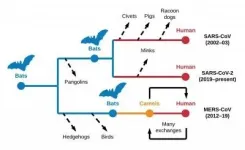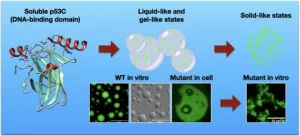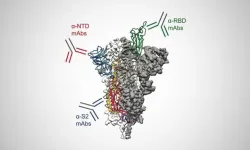Study explores how private equity acquisitions impact hospitals
2021-05-04
(Press-News.org) HOUSTON - (May 4, 2021) - Private equity investment in hospitals has grown substantially in the 21st century, and it accelerated in the years leading up the COVID-19 pandemic. Now a new study of short-term acute care hospitals acquired by private equity firms finds they not only have higher markups and profit margins, they're also slower to expand their staffs.
In a study published in Health Affairs, a multi-institutional team of investigators led by Dr. Anaeze C. Offodile II, a nonresident scholar in the Center for Health and Biosciences at Rice University's Baker Institute for Public Policy, the Gilbert Omenn Fellow at the National Academy of Medicine and an assistant professor of plastic and reconstructive surgery at The University of Texas MD Anderson Cancer Center, examined private involvement in short-term acute care hospitals and combed through proprietary databases to identify private equity transactions involving such hospitals between 2003 and 2017.
"Hospital spending accounts for one-third of U.S. health care expenditures, and there have been multiple news accounts of private equity investments in hospitals. But we know so little about how private equity acquisition influences hospitals' finance and operations," said Marcelo Cerullo, a surgical resident at Duke University Medical Center and the second author on the paper.
The researchers compared private equity-acquired hospitals to hospitals not involved in private equity deals using information drawn from Medicare cost reports and Area Health Resource Files. The study examined differences among private equity versus nonprivate equity hospitals in 2003 (before the acquisitions occurred) and 2017 (after the private equity deals were completed).
Over that period, private equity firms acquired 282 unique hospitals (some more than once) in leveraged buyouts in 36 different states. The study estimates that of all patient discharges in 2017, about 11% were from a hospital that had at one point been acquired by private equity. In 2003, hospitals that were subsequently acquired by private equity investors had higher charge-to-cost ratios, higher profit margins and comparable staffing ratios. However, post-acquisition in 2017, private equity-acquired hospitals had developed higher markups, even higher profit margins and saw slower rates of growth of staffing ratios. Notably, private equity-acquired hospitals had overall lower costs per each patient discharged.
"Our main findings highlight the overall solvency of private equity-acquired facilities, with strong baseline financial performance," Offodile said. "Our results challenge the prevailing narrative of financially distressed institutions seeking infusion of outside private equity capital. Post-acquisition, these hospitals appeared to continue to boost profits by restraining growth in cost per patient, in part by limiting staffing growth."
Hospitals acquired by private equity firms between 2003 and 2017 had operating margins that were 5.6 percentage points higher than nonprivate hospitals at the start of the period; that gap widened to 8.6 percentage points by 2017.
The authors also surveyed the press releases and industry-specific reports for private equity deals. Private equity firms often touted large capital investments that would maintain employment and commitments to the hospital's central mission. "We found a mixed track record of investors keeping specific promises after acquisition," Cerullo said. "Often, private equity firms would announce the dollar figure attached to renovations, new facilities, or give a time frame for staying open or maintaining raises."
The study forms a foundation for future investigations into how private equity acquisitions change hospital operations and clinical quality, the authors said.
"We need to conduct more detailed analyses before making specific policy recommendations involving private equity-acquired hospitals," said co-author Vivian Ho, a professor of economics at Rice and professor of medicine at Baylor College of Medicine. "For-profit hospitals have operated for several decades, but we need to determine whether the added presence of private equity induces additional efforts to maximize profits at the cost of harming patient welfare."
INFORMATION:
Other authors on the paper are Mohini Bindal, a former research assistant at the Baker Institute who is now a student at Baylor College of Medicine, and Alejandro Rauh-Hain, assistant professor of gynecologic oncology and reproductive medicine at MD Anderson.
For more information or to schedule an interview with one of the authors, contact Jeff Falk, director of national media relations at Rice, at 713-348-6775 or jfalk@rice.edu.
Related materials
Article: http://www.healthaffairs.org/doi/abs/10.1377/hlthaff.2020.01535
Offodile bio: http://www.bakerinstitute.org/experts/anaeze-c-offodile-ii
Cerullo bio: https://surgery.duke.edu/education-and-training/our-trainees/marcelo-cerullo
Ho bio: http://www.bakerinstitute.org/experts/vivian-ho
ELSE PRESS RELEASES FROM THIS DATE:
2021-05-04
ORLANDO, Fla. (May 3, 2021) - Researchers have identified a gene expressed in children with acute myeloid leukemia (AML) that could serve as a new immunotherapy treatment target, according to a new study published today in Blood Advances, a journal of the American Society of Hematology. The study, co-authored by researchers with Nemours Children's Health System, outlines the process and potential path for new immunotherapy drugs that improve survival and reduce treatment-related toxicity in children with AML.
Leukemia is the most common cancer in children and teens, and AML accounts for nearly one-fourth of those cases. AML is a fast-growing cancer that typically starts in immature bone marrow cells.
"Using ...
2021-05-04
Coronavirus (CoVs) infection in animals and humans is not new. The earliest papers in the scientific literature of coronavirus infection date to 1966. However, prior to SARS-CoV, MERS-CoV, and SARS-CoV-2, very little attention had been paid to coronaviruses.
Suddenly, coronaviruses changed everything we know about personal and public health, and societal and economic well-being. The change led to rushed analyses to understand the origins of coronaviruses in humans. This rush has led to a thus far fruitless search for intermediate hosts (e.g., civet in SARS-CoV and pangolin in SARS-CoV-2) rather than focusing on the important work, which has always been surveillance of ...
2021-05-04
When was the last time you repainted your car? Redesigned your coffee mug collection? Gave your shoes a colorful facelift?
You likely answered: never, never, and never. You might consider these arduous tasks not worth the effort. But a new color-shifting "programmable matter" system could change that with a zap of light.
MIT researchers have developed a way to rapidly update imagery on object surfaces. The system, dubbed "ChromoUpdate" pairs an ultraviolet (UV) light projector with items coated in light-activated dye. The projected light alters the reflective properties of the dye, creating colorful new images in just a few minutes. The advance could accelerate product development, enabling product designers to churn through ...
2021-05-04
Since it was first introduced in 2016, transparent wood has been developed by researchers at KTH Royal Institute of Technology as an innovative structural material for building construction. It lets natural light through and can even store thermal energy.
The key to making wood into a transparent composite material is to strip out its lignin, the major light-absorbing component in wood. But the empty pores left behind by the absence of lignin need to be filled with something that restores the wood's strength and allows light to permeate.
In earlier versions of the composite, researchers at KTH's Wallenberg Wood Science Centre used fossil-based polymers. Now, the researchers have successfully tested an eco-friendly alternative: limonene acrylate, a monomer made ...
2021-05-04
Cancer has been recently shown to be affected by protein clusters, particularly by the aggregation of mutant variants of the tumor suppressor protein p53, which are present in more than half of malignant tumors. However, how the aggregates are formed is not yet fully understood. The understanding of this process is expected to provide new therapeutic tools able to prevent proteins to clump and cancer progression.
In Brazil, researchers at the Federal University of Rio de Janeiro have identified a key mechanism behind the mutant p53 aggregation process, linked to cancer pathology, opening new paths for the development of novels ...
2021-05-04
BAR HARBOR, MAINE — Our kidneys are charged with the extraordinary task of filtering about 53 gallons of fluid a day, a process that depends on podocytes, tiny, highly specialized cells in the cluster of blood vessels in the kidney where waste is filtered that are highly vulnerable to damage.
In research at the MDI Biological Laboratory in Bar Harbor, Maine, a team led by Iain Drummond, Ph.D., director of the Kathryn W. Davis Center for Regenerative Biology and Aging, has identified the signaling mechanisms underlying podocyte formation, or morphogenesis. The discovery opens the door to ...
2021-05-04
A team of University of Alberta researchers has discovered a way to use 3-D bioprinting technology to create custom-shaped cartilage for use in surgical procedures. The work aims to make it easier for surgeons to safely restore the features of skin cancer patients living with nasal cartilage defects after surgery.
The researchers used a specially designed hydrogel--a material similar to Jell-O--that could be mixed with cells harvested from a patient and then printed in a specific shape captured through 3-D imaging. Over a matter of weeks, the material is cultured in a lab to become functional cartilage.
"It takes a lifetime to make cartilage in an individual, while this method takes about four weeks. So you still expect ...
2021-05-04
Metallacages prepared via coordination-driven self-assembly have received extensive attention because of their three-dimensional layout and cavity-cored nature. The construction of light-emitting materials employing metallacages as a platform has also gained significant interest due to their good modularity in photophysical properties, which bring emerging applications in fields as diverse as sensing, biomedicine, and catalysis.
However, the luminescence efficiency of conventional luminophores significantly decreases in the aggregate state because they encounter unfavorable aggregation-caused quenching (ACQ). Therefore, it was quite a challenge to fabricate light-emitting metallacages with high luminescence efficiency in various physical states.
In 2001, Tang's group ...
2021-05-04
The most complete picture yet is coming into focus of how antibodies produced in people who effectively fight off SARS-CoV-2 work to neutralize the part of the virus responsible for causing infection. In the journal Science, researchers at The University of Texas at Austin describe the finding, which represents good news for designing the next generation of vaccines to protect against variants of the virus or future emerging coronaviruses.
Previous research focused on one group of antibodies that target the most obvious part of the coronavirus's spike protein, called the receptor-binding domain (RBD). Because the RBD is the part of the spike that attaches directly to human cells and enables the virus to infect them, ...
2021-05-04
New York, NY (May 4, 2021) - A powerful, long-term study from WCS adds scientific backing for global calls for conserving 30 percent of the world's ocean. The studied no-take marine protected areas (MPAs) increased the growth of fish populations by 42 percent when fishing was unsustainable in surrounding areas, achieving the benefits of stable and high production of fish populations for fishers, while protecting threatened ecosystems.
The study recorded fish catches for 24-years across a dozen fish landing sites within two counties in Kenya, which allowed scientists to evaluate the long-term impacts of two different fisheries management methods. While one county ...
LAST 30 PRESS RELEASES:
[Press-News.org] Study explores how private equity acquisitions impact hospitals







